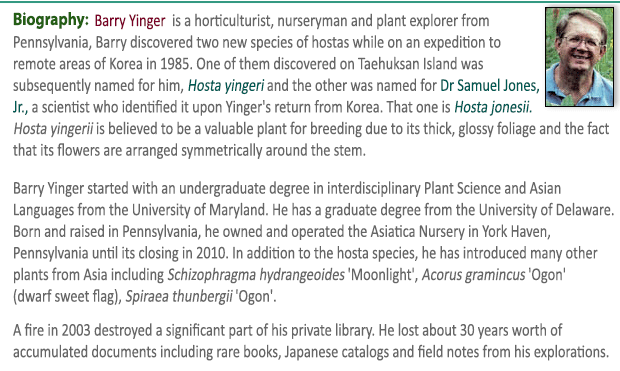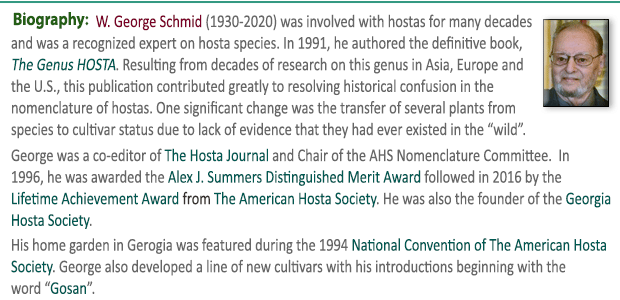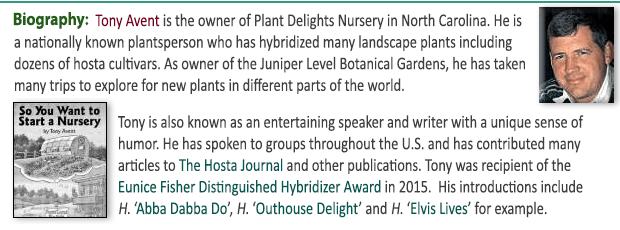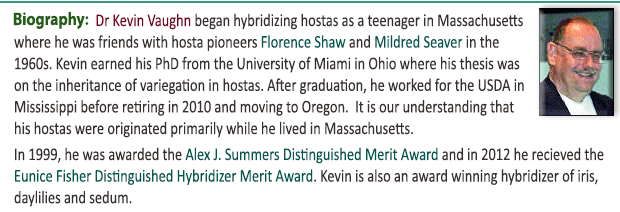|
 This species was named for
horticulturist,
Barry Yinger
of Asiatica Nursery in Pennsylvania after he
discovered it in 1984. The species was named in his honor by
Dr Samual B. Jones in 1989. It is native to the islands of
Taechuksan and Sohuksan near the southwest coast of
Korea. This species was named for
horticulturist,
Barry Yinger
of Asiatica Nursery in Pennsylvania after he
discovered it in 1984. The species was named in his honor by
Dr Samual B. Jones in 1989. It is native to the islands of
Taechuksan and Sohuksan near the southwest coast of
Korea. 
This species forms a small to medium size mound (9 to 19 inches
tall) of shiny leaves with thick substance. It has spider
shaped, purple flowers with purple anthers. The blossoms are evenly spaced along the scape and appear
from August into September followed by viable seeds.
H. yingeri, although a
recent discovery, has already been used extensively in
hybridizing by
Hostaphiles such as
Tony Avent,
Don Dean,
Roy Herold,
Greg Johnson, and
Bob Solberg.
The New Encyclopedia of Hostas by
Diana
Grenfell (2009) states: "Moderate growth rate...A superb hosta for
hybridizing as it passes on its very glossy leaves and spiderlike flowers...Very
thick, lustrous leaves..."
 
Warren I. Pollock in
The
Hosta Journal (1991 Vol. 22 No. 2) states that, "The
flowers of H. yingeri are atypical of most hosta species, having pale purple
lobes that spread in a "spider-flower" fashion. Also, the flowers are evenly
spaced around the central shaft...Hybridizers are now using H. yingeri to import
its good leaf substance, glossiness and unique flower character to seedlings."

An article by noted hosta hybridizer
Dr Kevin C
Vaughn in
The
Hosta Journal (1993 Vol. 24 No. 1) states that
“H. yingeri is a Korean species with very dark-green,
heavily substanced and ruffled leaves of medium size. The really
outstanding attribute of the plant is its bloomscape, on which
there are numerous, small, bright-purple flowers tightly
clustered and arranged in spirals around the bloomscape. This is
something quite different from the basically one-sided
bloomscapes which are typical of the genus…”

In
The
Hosta Journal (1995 Vol. 26 No. 2) Warren I. Pollock states that, "This
article is being written in August. H. laevigata is in full bloom and the
flowers are among the most beautiful and unusual of any hosta bloom.
W. George Schmid named this new species (laevigata means smooth, referring to the
leaves)...Visitors to our garden inquire what the hosta's name is, as they also
do for a H. yingeri clump which is growing nearby."

 In an article about hybridizing by
Tony Avent in
The
Hosta Journal (1996 Vol. 27 No. 1), he gives the
following comments: "H. 'Potomac Pride' - unique
hybrid of H. yingeri x H. 'Blue Cadet'
...a larger plant with spider-like flowers...future parent to many spectacular
introductions...Tony also comments on cultivars he has introduced: "...H. 'Outhouse Delight' is our biggest breakthrough, followed by H. 'Elvis Lives'. I am real
excited about a coming introduction, H. 'Old Yeller', a cross with
H. yingeri
and H. 'Sun Power'...pretty incredible...brilliant unique golden color, ruffled
leaves, yinger-like flowers...takes full sun...Oh, Baby!" In an article about hybridizing by
Tony Avent in
The
Hosta Journal (1996 Vol. 27 No. 1), he gives the
following comments: "H. 'Potomac Pride' - unique
hybrid of H. yingeri x H. 'Blue Cadet'
...a larger plant with spider-like flowers...future parent to many spectacular
introductions...Tony also comments on cultivars he has introduced: "...H. 'Outhouse Delight' is our biggest breakthrough, followed by H. 'Elvis Lives'. I am real
excited about a coming introduction, H. 'Old Yeller', a cross with
H. yingeri
and H. 'Sun Power'...pretty incredible...brilliant unique golden color, ruffled
leaves, yinger-like flowers...takes full sun...Oh, Baby!"

An article about favorite flowering hostas by W. George Schmid in
The
Hosta Journal (2006 Vol. 37 No. 2) says, "The best
flowers are on H. plantaginea and its multi-petalous cousins, 'Venus'
and
'Aphrodite'...H. capitata in bud is fine, but its offspring, 'Nakaimo' has
flowers that begin with the shine of precious porcelain and stay closed in bud
longer...H. kikutii forms all have fine and late flowers, but the best are on
H. kikutii var. densa (H. densa). They are white and form a tight bunch at the top
of the scape. H. laevigata has large, spidery flowers in abundance; its cousin
H. yingeri has smaller ones with the same spidery character and dark color.
These spidery flowers are carried all around the stem unlike other hosta flowers
that, "lean to one side...Finally, mature clumps of 'Blue Angel' and 'Elegans'
have a beautiful flower display when many flowers on different scapes open in
unison..."

 Glenn Herold in
The
Hosta Journal (2014 Vol. 45 No. 1) states
that, "Korea has eight native hosta species:
Hosta capitata,
H. clausa,
H. jonesii, H. laevigata,
H. minor,
H. tsushimensis,
H. venusta and
H . yingeri.
H. laevigata is closely related to H. yingeri, H. minor is closely related to H. venusta, and
H. tsushimensis is closely related to H. jonesii...H. yingeri is found only on the islands of Taehuksan and Sohuksan
off the southwest coast of Korea...It was discovered in 1984 by plant collector
Barry Yinger...H. yingeri is used extensively in breeding, especially by hybridizers
Bob Solberg,
Tony Avent ,
Greg Johnson,
Don Dean and
Roy Herold...Johnson crossed H. yingeri with 'Sum and Substance' to get 'Old Coot' and
'Jaz'. Both have good substance and shiny leaves. Glenn Herold in
The
Hosta Journal (2014 Vol. 45 No. 1) states
that, "Korea has eight native hosta species:
Hosta capitata,
H. clausa,
H. jonesii, H. laevigata,
H. minor,
H. tsushimensis,
H. venusta and
H . yingeri.
H. laevigata is closely related to H. yingeri, H. minor is closely related to H. venusta, and
H. tsushimensis is closely related to H. jonesii...H. yingeri is found only on the islands of Taehuksan and Sohuksan
off the southwest coast of Korea...It was discovered in 1984 by plant collector
Barry Yinger...H. yingeri is used extensively in breeding, especially by hybridizers
Bob Solberg,
Tony Avent ,
Greg Johnson,
Don Dean and
Roy Herold...Johnson crossed H. yingeri with 'Sum and Substance' to get 'Old Coot' and
'Jaz'. Both have good substance and shiny leaves.

The article also states
that, "...As the name laevigata implies, the upper and lower surfaces of the leaves
are polished. Also the leaves are longer and narrower and have greater substance
than H. yingeri. ..also claims the spider flower characteristic, but they are
larger than those of H. yingeri ...Unfortunately,
H. laevigata is difficult to
propagate by seed and hybridize because it does not readily form
seed pods.

As the name laevigata implies, the upper and lower surfaces of the leaves
are polished. Also the leaves are longer and narrower and have greater substance
than H. yingeri. ..also claims the spider flower characteristic, but they are
larger than those of H. yingeri ...Unfortunately,
H. laevigata is difficult to
propagate by seed and hybridize because it does not readily form seed pods."











 |



